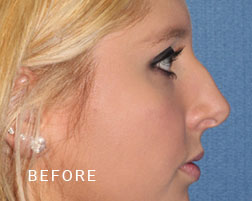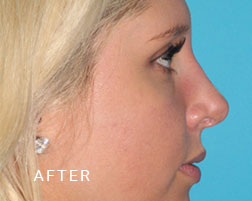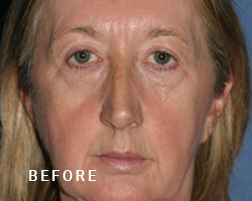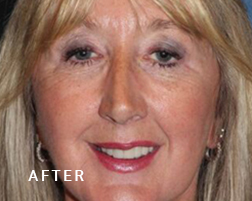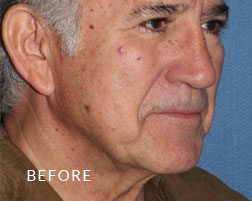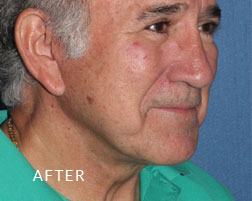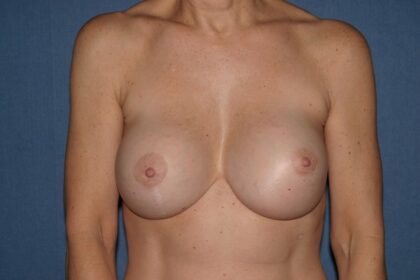Breast Implant-Associated Anaplastic Large Cell Lymphoma (BIA-ALCL)
Offered at our convenient location in Scottsdale, Arizona

Breast Implant-Associated Anaplastic Large Cell Lymphoma (BIA-ALCL or just ALCL) is a type of non-Hodgkin’s lymphoma. It is not breast cancer. Rather, it is a kind of cancer of the immune system that is shown to be associated with certain types of breast implants. While women who have undergone non-textured breast augmentation have no reason to be alarmed, it is in the interest of keeping our patients fully informed and educated that we share the following facts with you.
Contents
- 1 ALCL is Associated with Textured Breast Implants
- 2 Before and After Photos
- 3 Symptoms
- 4 How Does This Impact Those with Breast Implants?
- 5 What About Those Considering Breast Implants?
- 6 Treatment
- 7 Your Private Consultation Dr. Wolin
- 8 Breast Implant Exchange and Removal
- 9 How Much Does Breast Implant Exchange and Removal Cost in Arizona?
- 10 Patients Trust Dr. Wolin
- 11 FAQ
- 12 References
ALCL is Associated with Textured Breast Implants
This disease is a rare lymphoma (cancer of the lymph nodes and blood) that, to date, has only been associated with patients who have undergone a breast enhancement or reconstruction utilizing textured surface implants. Whether you’re a familiar friend or a brand new patient, Contact us to book your consultation. Call (480) 945-8440 to schedule an appointment.
Before and After Photos
Symptoms
ALCL usually develops as a delayed swelling of the breast after the insertion of textured breast implants. Patients notice inflammation at the site of their implants usually between two and twenty-eight years later (or, about eight years after their surgery, on average).[2] The swelling is typically a collection of fluid around the implant. The disease can also present as asymmetry of the breasts. Other possible symptoms include the appearance of a lump in the breast or armpit.
Why Does It Present in Only Textured Implants?
The present research cannot definitely say why textured implants are always the culprit associated with the disease. It may be chronic irritation caused by the irregular implant surface combined with a subclinical inflamed capsule. The breast “capsule” is the pocket of tissue that develops around the implant as the body becomes accustomed to it. At this point, the cause of ALCL has not been completely elucidated.
How Does This Impact Those with Breast Implants?
The FDA recommends that all patients with breast implants follow their routine mammographic guidelines. Patients should always examine their breasts daily while in the shower or getting dressed. Any suspicious changes to size, shape or discomfort should be brought to the attention of their plastic surgeons.
What About Those Considering Breast Implants?
The incidence of this disease is extremely low. However, Dr. Wolin has decided that he will no longer offer textured implants to any of his prospective patients.
“Even one patient out of thousands is too many to have this illness secondary to an elective aesthetic procedure.”
Dr. Wolin on Patient Safety
Treatment

In the vast majority of cases, the disease is confined to the capsule surrounding the implant. In these cases, complete removal of the capsule and the implant will cure the disease process without any other treatment.[3]
In those patients where the disease has progressed to the lymph nodes or spread to distant areas of the body, the treatment will also involve possible chemotherapy or radiation therapy.
Is Anaplastic Large Cell Lymphoma Curable?
The chances of recovery from ALCL is quite good, though it varies among demographic groups. Healthy, young patients under the age of 40 can be up to 90% likely to survive the disease beyond at least five years.[4]
Your Private Consultation Dr. Wolin
Dr. Andrew Wolin is a knowledgeable and compassionate doctor. When he learned of a possible connection between textured breast implants and an increased likelihood of coming down with a rare and mysterious lymphoma, he decided to take measured yet decisive action in defense of his community. Dr. Wolin invites his former breast augmentation patients or any other woman in the Scottsdale area to contact him if they suspect they may be at risk of ALCL. Every breast evaluation includes an Ultrasonic Breast Exam done in Dr. Wolin’s office by the doctor himself.
The local media celebrates Dr. Wolin because he affords answers and seeks solutions for all those who consult under his care.
Don’t wallow in worry. Take action! Begin a conversation with the Wolin Plastic Surgery center that won’t only change your life—it could save it. Call (480) 945-8440 to schedule your private consultation. We now offer remote appointments through Zoom video conferencing.
Breast Implant Exchange and Removal

In a great many cases, especially when it is caught early enough, Breast Implant-Associated Anaplastic Large Cell Lymphoma can be eliminated through a relatively simple Breast Implant Exchange or removal surgery. If you have already undergone breast augmentation, the implant exchange will seem comparatively easy.
As a general rule, breast implants in patients over 35 should be examined yearly by mammography and ultrasonography and periodically replaced every 10 to 20 years. Regular maintenance and upkeep will keep your appearance firm and fresh while you and Dr. Wolin can keep abreast of any developing issues.
Composite Capsulectomy (Formerly Known As En-Block Removal)
Composite capsulectomy is a type of breast implant removal and exchange. Dr. Wolin is elegantly adept and adroit at the delicate technique. During a composite capsulectomy, the contents of the implant are kept inside the intact capsule. This way the contents of the capsule will remain isolated from the open wound and reduce implant contamination to the surgery site.
Subtotal Capsulectomy
A subtotal capsulectomy is the partial removal of the scar tissue that develops around the breast implants. Errant scar tissue in the breast pocket can be responsible for a whole host of nefarious side effects, including ALCL. Additionally, the capsule of scar tissue may provoke an autoimmune response, furthering the enigmatic symptoms of complex biological/psychological disorders like Breast Implant Illness (BII).
How Much Does Breast Implant Exchange and Removal Cost in Arizona?
Dr. Wolin is both eager and able to help his Arizona community through any of the infrequent occurrences of Breast Implant-Associated Anaplastic Large Cell Lymphoma. He is uniquely positioned to both educate his patients on what they should know about this puzzling ailment and to guide them on a conclusive course of action. At your private consultation, Dr. Wolin shall determine if you would benefit from a breast implant exchange or removal. At this time, he will quote you an accurate cost.
Call (480) 945-8440 to schedule your consultation with one of Arizona’s best. We now offer Zoom video consults so you can start the conversation with us remotely from the secure comforts of home.
Patients Trust Dr. Wolin
Although the actual danger of this newly found textured breast implant disease exists, it is truly quite rare. Dr. Wolin feels that with proper patient education and continual communication between himself and his patients, the true risks of breast implant surgery are minimal. His substantial quantities of positive patient feedback illustrate his tender bedside manner. Dr. Wolin is a skilled and delicate surgeon. He cares about how his patients look and feel, from the inside out. If think that you or a loved one may be at risk for Breast Implant-Associated Anaplastic Large Cell Lymphoma, don’t wait until it’s too late to take action to stop this potentially serious illness. Please seek the consultation of an expert in healthcare and aesthetic medicine. Contact our offices and set up an informative appointment with one of our helpful representatives. You can trust Dr. Wolin to see you through this unforeseen uncertainly.
FAQ
What are the symptoms of Breast Implant-Associated Anaplastic Large Cell Lymphoma (BIA-ALCL)?
People with ALCL may notice that their breasts are swollen and sensitive. Some patients describe pain and pressure in the chest and in the lungs. BIA-ALCL can take a long time to develop, with the earliest cases appearing two years after breast augmentation surgery and some cases presenting up to two decades later. You should closely monitor breast implants as part of your routine self-care. Notify your physician immediately if you believe you may be experiencing the symptoms of ALCL.
How do you treat Breast Implant-Associated ALCL?
If the disease is caught early enough, you can purge the cancer cells from your body by removing or exchanging the involved implant. A skilled plastic surgeon will be able to conduct the delicate excision with minimal risk to the patient. In more advanced cases, you may require a chemotherapy or radiotherapy regimen to eliminate the white blood cells before the illness spreads through the lymphatic system. In most cases, and with timely and appropriate treatment, ALCL can be driven into remission.
References
- Carter, M., & Purpura, J. (2015). Anaplastic Large Cell Lymphoma Occurring in Women with Breast Implants. Plastic and Reconstructive Surgery, 136(1). doi:10.1097/prs.0000000000001350
- Hu, H., Johani, K., Almatroudi, A., Vickery, K., Natta, B. V., Kadin, M. E., . . . Deva, A. K. (2016). Bacterial Biofilm Infection Detected in Breast Implant–Associated Anaplastic Large-Cell Lymphoma. Plastic and Reconstructive Surgery, 137(6), 1659-1669. doi:10.1097/prs.0000000000002010
- Kenkel, J. M. (2011). Discussion: Anaplastic Large Cell Lymphoma and Breast Implants: A Systematic Review. Plastic and Reconstructive Surgery, 127(6), 2151-2153. doi:10.1097/prs.0b013e318219c741
- Popplewell, L., Thomas, S. H., Huang, Q., Chang, K. L., & Forman, S. J. (2011). Primary anaplastic large-cell lymphoma associated with breast implants. Leukemia & Lymphoma, 52(8), 1481-1487. doi:10.3109/10428194.2011.574755




